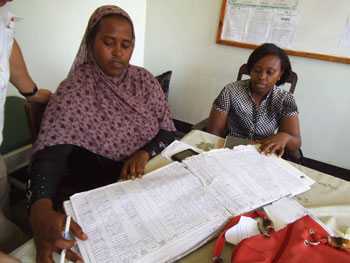Field Epidemiology and Laboratory Training Program
What is the Field Epidemiology and Laboratory Training Program?

Field Epidemiology and Laboratory Training Programs (FELTPs) are applied epidemiology training programs offered by CDC to help countries develop, set up and implement dynamic public health strategies to improve and strengthen their public health systems and infrastructures.
FELTP fellows spend the majority of their two-year tenure working in the field. Field activities include conducting epidemiologic investigations and field surveys, evaluating surveillance systems, and then reporting their findings to decision- and policy-makers. Additionally, they complete coursework in epidemiology, communication, economics, and management. Fellows can also conduct small projects which focus on topic areas addressing specific country needs. FELTPs provide a tremendous opportunity to enhance public health expertise at the country level.
If your FELTP program is interested in working with CDC, please let us know. Contact us at BirthDefectsCOUNT@cdc.gov.
How do Birth Defects COUNT and FELTPs work together?
Surveillance provides a foundation for many public health activities, including birth defects prevention. It provides the data necessary to make informed decisions. Surveillance can also provide information about whether intervention efforts are meeting their intended goals. Birth Defects COUNT is working with FELTPs in a number of countries across different regions of the world to strengthen birth defects surveillance. FELTPs provide the opportunity for a targeted, tailored approach to birth defects surveillance and prevention.
Over the past several years, Birth Defects COUNT has supported the implementation and provision of scientific technical assistance to several year-long individualized FELTP projects in Mexico and Colombia with a focus on increasing capacity for birth defects surveillance and field surveys. Birth Defects COUNT is currently providing support and technical assistance to FELTP programs in Kenya, Tanzania, Nigeria, and Afghanistan on the development and implementation of birth defects surveillance programs.
Training Program Fact Sheet
Mexico
Evaluation of mandatory folic acid supplementation guidelines in Mexico City
Mexico recommends that all pregnant women attending primary healthcare centers should receive folic acid supplements. FELTP fellows are evaluating current knowledge and practice among physicians and women around recommending or using folic acid supplements. They are conducting surveys at select Mexico City primary healthcare centers to assess knowledge of the recommendation among pregnant women, women of childbearing age, and physicians. FELTP fellows are also evaluating the availability of folic acid supplements at the primary healthcare centers. Results from the evaluation could highlight gaps in knowledge about the importance folic acid consumption before and during early pregnancy among both women of reproductive age and their health care providers. Results could also demonstrate whether or not there is sufficient stock of folic acid supplements at the primary healthcare centers.
Evaluation of a neural tube defects surveillance system in Mexico
Since 1993, Mexico has had a neural tube defects surveillance system. FELTP fellows are assessing the quality of this existing system. They will evaluate system attributes such as sensitivity, positive predictive value, and data quality. Based on the results, the FELTP fellow will submit recommendations to health officials to improve the neural tube defects surveillance system. Such improvements could lead to more accurate and timely data for planning birth defects prevention efforts.
Colombia
Implementing a birth defects surveillance system in Riosucio, Caldas, Colombia
FELTP fellows are developing a birth defects surveillance system in the zone of Riosucio (state of Caldas). This project will identify, confirm, and characterize the most common birth defects among children 5 years of age or younger. Having more information about the burden of birth defects in this population will help local health officials plan prevention efforts as well as help inform future birth defects investigations in the area.
Burden of birth defects in prenatal and neonatal deaths: an analysis of vital statistics
In 2006, birth defects were the second leading cause of death for children less than one year of age in Colombia. Colombia has a national vital statistics database that contains information on birth defects. FELTP fellows are analyzing the database to estimate prenatal and neonatal deaths due to birth defects. They will then characterize this information by sociodemographic and geographic characteristics, and explore relationships between maternal risk factors and birth defects. Findings from this investigation will provide health officials with an estimated burden of the effects of and complications related to birth defects in Colombia, and will help inform prevention efforts.
Kenya
Assessing the prevalence of neural tube defects in Kenya
In 2012, a neurosurgeon at Kijabe Hospital in Kenya was concerned about a high occurrence of neural tube defect cases and contacted CDC for technical assistance. CDC worked with FELTP-Kenya staff to conduct a preliminary assessment at Kijabe Hospital. CDC provided technical assistance on the development of a report on the burden of neural tube defects and on a presentation of findings to country health officials. Discussions about future activities include a comparison of Kijabe Hospital findings to other hospitals in the region, and the development of a population-based birth defects surveillance system for Kenya.
What’s next?
Birth Defects COUNT will continue to collaborate with FELTPs to further strengthen birth defects surveillance expertise and capacity at the country level. Efforts will increase the availability of reliable birth defects surveillance data so countries can better define the true burden of neural tube defects, and develop and assess the impact of their prevention activities.
- Page last reviewed: April 26, 2017
- Page last updated: March 31, 2016
- Content source:


 ShareCompartir
ShareCompartir